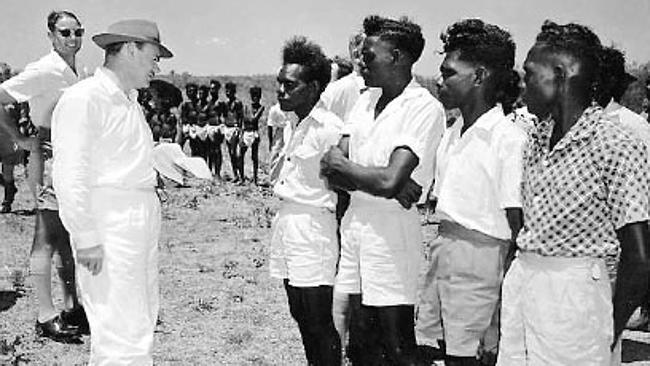Paul Hasluck: the model of a governor-general
FOR 20 years, from 1949, Fremantle-born Paul Hasluck was one of Australia’s most prominent conservative federal politicians.

FOR 20 years, from 1949, when he won the newly created Perth-based seat of Curtin, Fremantle-born Paul Hasluck was one of Australia’s most prominent conservative federal politicians. Born into a Salvation Army family, Hasluck played a leading role in Aboriginal affairs and indigenous reform and also in helping prepare Papua New Guinea for independence.
After Liberal prime minister Robert Menzies in 1951 appointed him minister for territories, a position he held for 12 years, Hasluck (1905–93) was minister for external affairs for almost five years from 1964, after briefly having been minister for defence.
When Harold Holt died in December 1967, Hasluck helped ensure that the treasurer, William McMahon, whom he justifiably distrusted, did not take over as prime minister.
Then in early 1969 Liberal prime minister John Gorton appointed the highly capable Hasluck as our 17th governor-general. This was a position Hasluck held until July 1974, after which John Kerr replaced him.
As Geoffrey Bolton explains in this captivating biography:
throughout his intriguing life, Hasluck published five volumes of poetry, two autobiographies and numerous works about history and politics.
Before entering federal parliament, Hasluck had been a journalist who also lectured in history at the University of Western Australia, where he had gained a master of arts degree.
In what has proved highly advantageous, Hasluck’s only surviving son, Nicholas Hasluck, has afforded Bolton unrestricted access to the papers and books of his parents Sir Paul and Lady Alexandra Hasluck. Aided by his wife Sally Anne, Nicholas Hasluck consistently helped Bolton — who is one of our most accomplished writers and prolific historians — to find and identify the most useful sources from the extensive Hasluck collection of which he and his wife are the literary executors. Perhaps as importantly, they neither sought to influence either Bolton’s ultimate choice of material nor his interpretation of the fascinating life and times of the elder Haslucks.
Of the many crucial matters explored in this important book, chapter 18, “The year of living dangerously”, deals with the decision in 1965 to send Australian troops to the war in Vietnam. Although Hasluck entirely supported our involvement, as Bolton explains he would have much preferred to have received an undertaking that if the Australians were needed closer to home (for example if there was trouble with Indonesia over Papua New Guinea), the Americans would provide the means to pull them out of Vietnam.
Hasluck was thinking of the precedent during the 1939-45 war when, although Winston Churchill didn’t like it, the conservative Arthur Fadden and Labor PM John Curtin both insisted that Australians serving in North Africa should be brought home to defend Australia.
However, Hasluck was overruled about Vietnam and, with some private reluctance, submitted to the decision of federal cabinet, led by the powerful Menzies.
Some earlier chapters, including those dealing with the mid-1940s when Hasluck represented Australia at the UN, are of considerable interest. So too are Bolton’s analyses of Hasluck’s dealings with Labor luminary and future federal leader of the ALP, the often erratic HV Evatt.
The material about Hasluck and the UN, especially in 1946, also focuses on his relationship with Ian Milner who worked under John Burton in Evatt’s Department of External Affairs. Although Milner was a communist, Hasluck had trusted him. But when incontrovertible evidence emerged proving that Milner was an integral part of an organised Australian Soviet spy network, Hasluck — who was previously tolerant about communists — became much more strongly anti-communist.
Extensively researched, Paul Hasluck: A Life is especially revealing about the relationship between Hasluck and Kerr, who was among those he had suggested to Gough Whitlam as his possible replacement.
Bolton’s penultimate chapter, “A vigorous retirement”, deals in detail with Kerr’s dismissal of Labor PM Whitlam on November 11, 1975 and Hasluck’s reactions to it. As some of this material is new, I won’t spoil the readers’ enjoyment by spilling all the beans. Suffice it to say that Kerr had no hesitation in consulting old colleagues from the Sydney bar, even if it meant possibly compromising half the members of the High Court who, Bolton explains, “might at some future time be required to pronounce on the constitutional validity of his actions”.
Yet apparently Kerr made no attempt to consult his predecessors as governor–general (William McKell, Lord Casey and Hasluck) even though all three had long experience of parliamentary politics as well as serving in the vice-regal role!
As Bolton explains, the repercussions of Whitlam’s dismissal lingered into 1977. When Hasluck visited London that August, the Queen’s private secretary, Martin Charteris, took the opportunity for a long and confidential interview with him, seeking an update on opinion in Australia, as well as Hasluck’s thoughts about Kerr’s dismissal of Whitlam and his replacement by Malcolm Fraser as caretaker prime minister ahead of a general election.
All of this is fascinating material indeed. But hidden among the many revealing, mainly black-and-white illustrations in this finely honed biography is a coloured photograph of a stuffed Sumatran tiger. Presented to Hasluck by president Sukarno of Indonesia, the hapless animal is, Bolton informs us, permanently housed as the mascot of the Claremont Football Club, nicknamed the Tigers, which for decades has played Aussie rules in the West Australian Football League.
If this is still the situation, 2015 is surely the year to save this magnificent Sumatran tiger from public view and humiliation?
Ross Fitzgerald is emeritus professor of history and politics at Griffith University and author of 36 books.
Paul Hasluck: A Life
By Geoffrey Bolton
UWA Publishing, 492pp, $49.99


